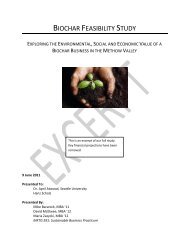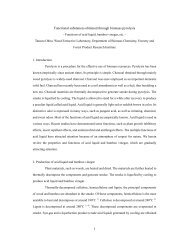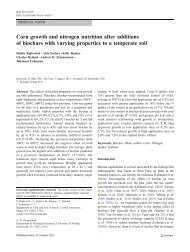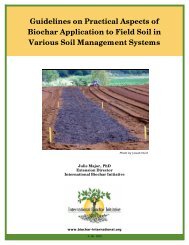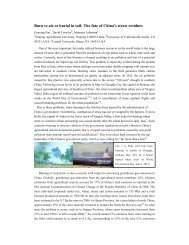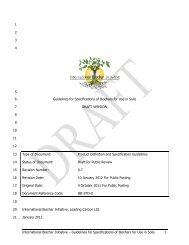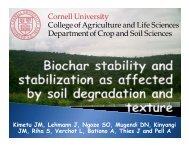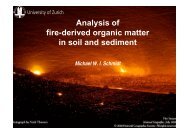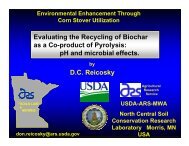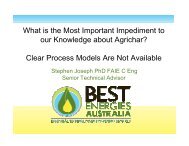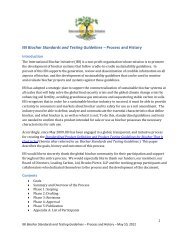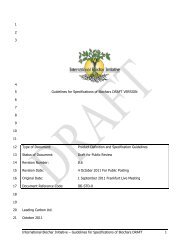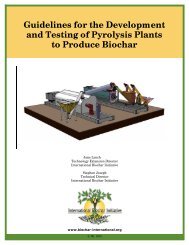a copy of the Webinar Presentation - International Biochar Initiative
a copy of the Webinar Presentation - International Biochar Initiative
a copy of the Webinar Presentation - International Biochar Initiative
You also want an ePaper? Increase the reach of your titles
YUMPU automatically turns print PDFs into web optimized ePapers that Google loves.
Process and Document Overview<br />
<strong>International</strong> <strong>Biochar</strong> <strong>Initiative</strong><br />
and Leading Carbon Ltd.<br />
October 2011
Introduction<br />
◦ Presenters<br />
◦ <strong>International</strong> <strong>Biochar</strong> <strong>Initiative</strong><br />
History <strong>of</strong> <strong>the</strong> Process<br />
Document Overview:<br />
◦ Guideline Scope<br />
◦ Definitions<br />
◦ Feedstock Requirements and Process Recommendations<br />
◦ Levels and Test Details<br />
◦ Using <strong>the</strong> Guidelines<br />
Next Steps<br />
Questions
<strong>International</strong> <strong>Biochar</strong> <strong>Initiative</strong><br />
Debbie Reed/Kelpie Wilson<br />
Leading Carbon<br />
Keith Driver<br />
Alison Lennie
Who we are….<br />
…a non-pr<strong>of</strong>it organization supporting<br />
researchers, commercial entities, policy<br />
makers, development agents, farmers and<br />
gardeners committed to sustainable biochar<br />
production and use.<br />
Our mission…<br />
…is to promote <strong>the</strong> development <strong>of</strong> biochar<br />
systems that follow cradle-to-cradle<br />
sustainability guidelines.
Our vision….<br />
…is to support <strong>the</strong> commercialization <strong>of</strong> sustainable<br />
biochar systems at all scales by 2015 that will…<br />
◦ Help solve <strong>the</strong> global food security crisis and ensure soil<br />
security with <strong>the</strong> use <strong>of</strong> biochar;<br />
◦ Help solve <strong>the</strong> global climate change crisis with <strong>the</strong> use <strong>of</strong><br />
biochar; and<br />
◦ Help make agricultural production at all scales more<br />
sustainable with <strong>the</strong> use <strong>of</strong> biochar.
IBI’s VISION:<br />
<br />
◦ Help attain <strong>the</strong> commercial viability <strong>of</strong> sustainable biochar<br />
production and utilization at all scales,<br />
◦ Enhance <strong>the</strong> global soil resource, and<br />
◦ To help combat climate change<br />
Before <strong>the</strong> industry can succeed in <strong>the</strong>se efforts, we<br />
must be able to define, analyze and communicate <strong>the</strong><br />
essential characteristics that make biochar useful<br />
<br />
To do this, we must establish guidelines and tests to<br />
confirm that a product intended for sale or use as<br />
biochar possesses <strong>the</strong> necessary characteristics for<br />
safe use
improve<br />
product<br />
quality<br />
enhance<br />
safety<br />
facilitate<br />
market access<br />
and trade<br />
build<br />
consumer<br />
confidence in<br />
biochar<br />
products
<strong>Biochar</strong> is a spectrum <strong>of</strong> materials with a<br />
range <strong>of</strong> different properties<br />
<br />
<br />
<br />
<br />
Both beneficial and challenging<br />
Researchers are challenged to match results to<br />
particular traits and characteristics<br />
Guidelines for Specifications <strong>of</strong> <strong>Biochar</strong>s will assist <strong>the</strong><br />
research community by providing a framework for<br />
consistent biochar characterization<br />
<strong>Biochar</strong> is a relatively new field. These Guidelines will be<br />
revised in an iterative process based on new<br />
developments in <strong>the</strong> science <strong>of</strong> biochar
<strong>Biochar</strong> is a spectrum <strong>of</strong> materials with a<br />
range <strong>of</strong> different properties<br />
<br />
<br />
<br />
Soils are also extremely heterogeneous<br />
The range <strong>of</strong> biochar end uses is broad, with different<br />
material requirements for different purposes, different<br />
soils, and different applications<br />
This is good news because it means that <strong>the</strong>re are a<br />
large number <strong>of</strong> potential markets for biochar materials,<br />
once <strong>the</strong> challenges <strong>of</strong> characterizing and matching<br />
biochars to applications are overcome
Certification/Standardization Effort<br />
Announced in Rio de Janeiro 2010<br />
Phase 1: Collaborative <strong>International</strong> Working<br />
Groups - late 2010 to spring 2011<br />
Phase 2: Live Meeting <strong>of</strong> Experts Frankfurt -<br />
July 2011<br />
Live posting <strong>of</strong> document - October 2011
Adherence to global, transparent, fully-documented process<br />
congruent with existing standard-setting bodies such as ISO<br />
Relies on existing research and knowledge and built from<br />
accepted methodologies, standards, regulations and tests<br />
Public input solicited and incorporated throughout <strong>the</strong><br />
process<br />
Document will evolve over time in an iterative process with<br />
revisions as warranted
Adherence to process is extremely important<br />
Part <strong>of</strong> <strong>the</strong> process is documentation <strong>of</strong> each step undertaken<br />
with <strong>the</strong> global community <strong>of</strong> biochar stakeholders<br />
Documentation <strong>of</strong> <strong>the</strong> IBI Guidelines development process is<br />
available to any entity that wishes to take <strong>the</strong>se guidelines and<br />
build upon <strong>the</strong>m.<br />
Rigorous documentation provides <strong>the</strong> basis for fur<strong>the</strong>r<br />
development <strong>of</strong> <strong>the</strong> IBI Guidelines for Specifications <strong>of</strong> <strong>Biochar</strong>s<br />
under any o<strong>the</strong>r standards development or regulatory process.
Accepting public comment from October 15, 2011<br />
until November 15, 2011<br />
Incorporation <strong>of</strong> public comment and document<br />
revision<br />
Posting <strong>of</strong> revised document in December 2011<br />
Balloting by IBI membership to accept or reject<br />
revised document<br />
IBI must raise funds to pay for a legal review <strong>of</strong> <strong>the</strong><br />
final document before it can be published and put<br />
into service.
Guidelines for Specification <strong>of</strong> <strong>Biochar</strong>s<br />
◦ Guideline Scope<br />
◦ Definitions<br />
◦ Feedstock Requirements and Process<br />
Recommendations<br />
◦ Levels and Test Details<br />
◦ Using <strong>the</strong> Guidelines
Feedstock Carbonization <strong>Biochar</strong> End Use<br />
What IS biochar?<br />
Physical and chemical properties <strong>of</strong> biochar<br />
Material properties reporting<br />
Basis for IBI certification and 3 rd party standards<br />
NOT a sustainability standard<br />
NOT a production procedure guideline<br />
NOT an end-use guideline
Who will use <strong>the</strong> Guidelines?<br />
<strong>Biochar</strong> producers<br />
<strong>Biochar</strong> marketers<br />
Users<br />
Regulators<br />
Researchers<br />
National and regional IBI affiliates can adapt<br />
<strong>the</strong>se guidelines to <strong>the</strong>ir local jurisdictions
Who will participate in <strong>the</strong> IBI Certified <strong>Biochar</strong><br />
Label Program?<br />
IBI<br />
<strong>Biochar</strong> producers<br />
<strong>Biochar</strong> distributors and marketers<br />
Testing labs<br />
Who will benefit from <strong>the</strong> program?<br />
Producers<br />
Distributors and marketers<br />
Users
How will <strong>the</strong> label be used?
Focus on biochar contents and properties, not<br />
carbonization process or end use<br />
Phrased for relevance to document<br />
Concerning key constituents <strong>of</strong> biochar as a final<br />
product<br />
◦ e.g. ash, organic carbon<br />
Related terms used in document<br />
◦ e.g. feedstock, biomass, carbonization<br />
Areas <strong>of</strong> concern (regulatory or o<strong>the</strong>rwise)<br />
◦ e.g. contaminant, diluent, MSW
<strong>Biochar</strong>: A solid material obtained from <strong>the</strong><br />
carbonization <strong>of</strong> biomass.<br />
<strong>Biochar</strong> MUST be made from biomass.<br />
<br />
Biomass: The biodegradable fraction <strong>of</strong> products,<br />
waste and residues <strong>of</strong> biological origin from<br />
agriculture (including vegetal and animal substances),<br />
forestry, and related industries including fisheries<br />
and aquaculture, as well as <strong>the</strong> biodegradable<br />
fraction <strong>of</strong> industrial and municipal waste (including<br />
municipal solid waste).
<strong>Biochar</strong> Characteristics: those physical properties<br />
that affect <strong>the</strong> following uses <strong>of</strong> biochar:<br />
1. biochar that is added to soils with <strong>the</strong> intention to<br />
improve soil functions; and<br />
2. biochar that is produced to convert a portion <strong>of</strong><br />
<strong>the</strong> biomass feedstock into a stable carbon<br />
fraction, which has carbon sequestration value.<br />
This is done in order to reduce emissions from<br />
biomass (that would o<strong>the</strong>rwise naturally degrade<br />
to greenhouse gases).
Diluent/Dilutant: Inorganic material that is<br />
deliberately or inadvertently comingled with<br />
biomass feedstock prior to processing.<br />
◦ Materials will not carbonize in an equivalent fashion<br />
to <strong>the</strong> biomass.<br />
◦ Includes common constituents <strong>of</strong> natural soils, such<br />
as clays and gravel that may be ga<strong>the</strong>red with<br />
biomass or intermixed through prior use <strong>of</strong> <strong>the</strong><br />
feedstock biomass.<br />
◦ May be found in a diverse range <strong>of</strong> feedstocks, such<br />
as agricultural residues and municipal solid wastes.
Processed vs. Unprocessed Feedstock<br />
<br />
Processed Feedstock: Biomass that has gone through<br />
chemical processing (for example, chemical treatment such<br />
as occurs with wood preservatives and paper pulp sludges) or<br />
biological processing (for example, digestion, such as<br />
manures and sludge from waste effluent treatment) beyond<br />
simple mechanical processing to modify physical properties.<br />
<br />
Unprocessed Feedstock: Biomass that has not gone through<br />
chemical or biological processing, but may have gone<br />
through mechanical processing to change its physical<br />
properties, including particle size.
Feedstock content, quality & reporting:<br />
<br />
<br />
<br />
<br />
Feedstock type must be declared, as feedstock<br />
affects final biochar product quality.<br />
Feedstocks must be biomass-sourced.<br />
No more than 2% (dry wt) contaminants<br />
MSW containing hazardous materials or wastes may<br />
not be included as eligible feedstocks under <strong>the</strong>se<br />
guidelines<br />
Only unprocessed feedstocks are eligible for Level 1<br />
testing category.
These Guidelines are not prescriptive <strong>of</strong><br />
production and handling.<br />
Guidelines recommend:<br />
Adherence to local regulations<br />
Material Safety Data Sheet (MSDS)<br />
Good business practices
Not prescriptive <strong>of</strong> sustainability or production<br />
process<br />
Process and Sustainability Guidelines will be<br />
addressed by IBI in future documents<br />
View background papers on biochar sustainability<br />
on <strong>the</strong> IBI <strong>Biochar</strong> Sustainability page:<br />
www.biochar-international.org/sustainability
Testing Level Categories are designed to:<br />
<br />
<br />
Enable comparison <strong>of</strong> different biochars through<br />
uniform presentation<br />
Incrementally increase testing requirements so that<br />
higher levels <strong>of</strong> characterization & testing provide a<br />
more comprehensive understanding <strong>of</strong> <strong>the</strong><br />
composition and properties <strong>of</strong> <strong>the</strong> material<br />
Test level categories are cumulative - higher category<br />
levels include all preceding lower level tests.<br />
Level 1 test category sufficient to protect against harm,<br />
but still affordable by small producers
Tests were chosen according to <strong>the</strong>se criteria:<br />
Tests that could accurately measure biochar<br />
characteristics <strong>of</strong> concern<br />
Uses standardized, peer-reviewed, already<br />
approved & in-use tests, thresholds and<br />
methodologies<br />
Intended to improve/expand with evolving<br />
science<br />
To be accessible, accurate and affordable
Level 1<br />
Entry<br />
Level<br />
Level 2<br />
Moderate<br />
Level 3<br />
Advanced<br />
Testing Level 1: Basic parameters to assess<br />
utility. Applies only to biochars from<br />
unprocessed feedstocks.<br />
Testing Level 2: Basic analysis and enhancement<br />
properties, meeting toxicity thresholds.<br />
Testing Level 3: Advanced analysis and<br />
enhancement properties, meeting additional<br />
toxicity thresholds.
Testing Level 1<br />
Exclusively From Unprocessed Feedstocks<br />
Basic <strong>Biochar</strong> Characteristics<br />
◦ Moisture, ash, carbon, H:C, N, pH, liming, particle<br />
size distribution<br />
Vegetative and Invertebrate Vigour<br />
◦ Based on OECD(Organization for Economic and Cooperative<br />
Development) analysis
Testing Level 2<br />
Meets Level 1 quality reporting, but can be <strong>of</strong><br />
processed or unprocessed feedstock origin<br />
Basic Soil Toxicity Thresholds/Declarations<br />
◦ As, Cd, Cr, Co, Cu, Pb, Mo, Hg, Ni, Se, Zn, B, Cl, Na*<br />
Basic Soil Enhancement Properties<br />
◦ Total K, Total P, Available P, Mineral N, Electrical<br />
Conductivity<br />
◦ *underlined elements have maximum content<br />
thresholds non-underlined elements require<br />
content declarations only
Testing Level 3<br />
Meets Level 2 quality reporting<br />
Advanced Soil Toxicity Thresholds<br />
◦ PCBs, PAHs, Furans, Dioxins<br />
Advanced Soil Enhancement Properties<br />
◦ Porosity, Surface Area
Over time, as scientific knowledge and<br />
technology advance, <strong>the</strong> tests and testing<br />
levels may change:<br />
Better or more accurate tests may be<br />
developed to replace current tests<br />
New tests measuring new attributes may be<br />
developed<br />
Additional testing level categories could be<br />
added or existing levels re-configured
Labeling: visible label with all information, OR<br />
link to website with information.<br />
MUST BE EASILY UNDERSTOOD & ACCESSIBLE<br />
Feedstock, country <strong>of</strong> origin, test level reporting<br />
Includes special instructions such as handling,<br />
transportation, MSDS, HMIS (Hazardous Material<br />
Identification System) etc.
SAMPLE LABEL
Sampling and Testing must be conducted:<br />
◦ every 600 tonnes <strong>of</strong> consistent feedstock through-put, or<br />
◦ every 6 months, or<br />
◦ after a material change in feedstock, or<br />
◦ after a material change in production parameters<br />
Before final storage and shipping<br />
By trained & accredited pr<strong>of</strong>essionals.<br />
Documentation should include chain <strong>of</strong><br />
custody and product traceability information
Live posting October 2011<br />
<br />
<br />
Public Comment Period - October 15 to November<br />
15, 2011<br />
Document revisions<br />
Document re-posting December 1, 2011<br />
Balloting Period (IBI Members Only) December 15-31,<br />
2011)<br />
<br />
Legal Review (Funds must be raised first)<br />
Guideline Implementation January 2012<br />
<br />
Development <strong>of</strong> Certification Process TBA
FAQs<br />
How do I know an IBI labelled biochar is safe<br />
to use?<br />
Will <strong>the</strong>se tests help me meet <strong>the</strong> regulatory<br />
requirements for soil amendments in my<br />
country?<br />
Can I substitute different test methods that I<br />
use on a regular basis instead <strong>of</strong> <strong>the</strong><br />
referenced methods?
Questions? E-mail us:<br />
<strong>Biochar</strong>GuidelineIBI@gmail.com



